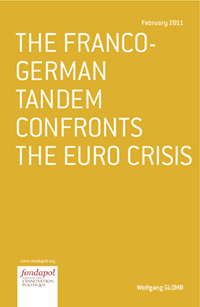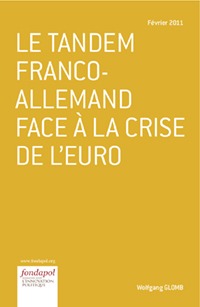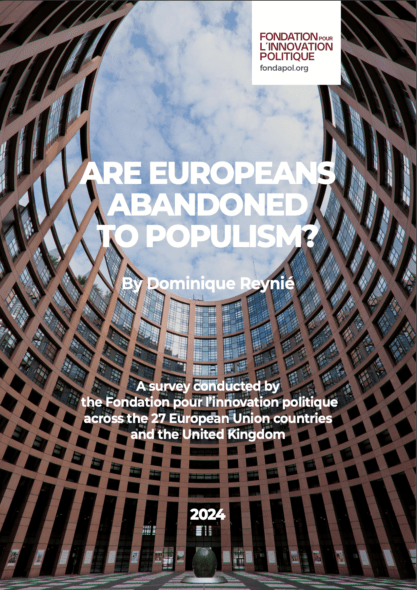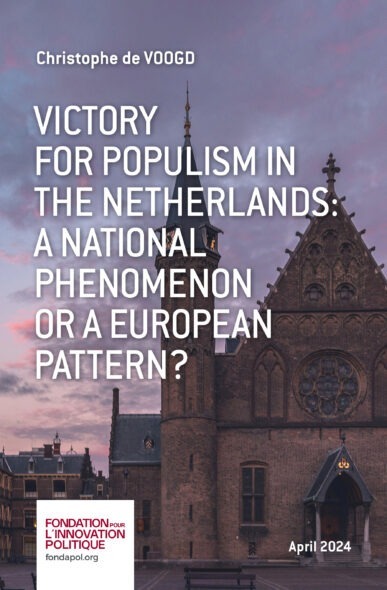The franco-german tandem confronts the Euro crisis
Introduction
From the Werner plan to the euro rescue operation
The currency snake
The European Monetary System (EMS)
Towards a single currency
The euro rescue operation
Institutions promoting Franco-German co-operation
Franco-German reaction to the financial crisis
Different structures
Contrasting reactions
Collateral damage caused by the financial and economic crisis
A worrisome deterioration of public finances
Budgetary consolidation ratio
Financial policy within the EMU
Options for budgetary consolidation
European economic as an institutional alternative
The United States and Japan: delayed-action bomb
The U.S.: Debt and international dependency
Japan: A troubling financial situation
Emerging from the crisis
Reforming the Stability and Growth Pact (SGP)
Strengthening the market mechanism
Systemic Risk
Conclusion
Abstract
The history of European integration is also that of monetary integration. Franco-Germany co-operation has always played a decisive role in European monetary policy. It is in this area that disagreements persist between the two countries, as well as a desire to arrive at a compromise without which the euro would not exist.
The monetary issue only became significant in Europe with the growing integration into the Common Market and the collapse of the International Monetary System. A closer co-operation within the European Currency Snake failed because of the lack of synchronised economic policies. Later, the European Monetary System (EMS) was launched in a turbulent environment but stabilised after the “move to a policy of austerity” decided by François Mitterrand.
This trend led to the first debates in France on how to create a common European currency, echoed by similar ideas on the German side. However, many Franco-German divergences persisted and the Treaty of Maastricht corresponded more to the German concept of stability.
Such ideas were not fully implemented during the first ten years of the euro’s existence. In the spring of 2010, the economic differences between the Member States caused turbulence in the financial markets and to the threat of default on the part of Greece. Germany had to abandon all of the principles it had defended up to that point during the euro rescue operation.
Similarly, adopting the reform of the Stability and Growth Pact called for a Franco-German entente. The French concept of political primacy prevailed over the German preference for strict budgetary rules. The question now lies in the euro’s long-term stability. If the latter is not secure, the choice of a union of financial transfers will become inevitable, with all of the consequences that it would imply in the realm of domestic policy (notably right-wing radicalisation in Germany). The Franco-German tandem therefore must maintain close co-operation in order to prevent such a situation, which would be critical for all of Europe.
Wolfgang Glomb,
Economist, member of the Franco-German Council of Economic Analysis and Chairman of the Association of German Economists’ “European Integration” working group.
Christian Stoffaës, Convergences et divergences économiques franco-allemandes: une perspective, Le Cercle des économistes, “L’Allemagne, un modèle pour la France ?” Cahier l’Allemagne, 2008.
“Europe will be created by means of a single currency or not at all” (Jacques Rueff, French senior official and economist, 1949).
“If the euro fails, Europe will fail, and with it the idea of European unity” (German Chancellor Angela Merkel, May 2010).
Sixty years separate these two statements, yet both attest to the pre-dominant role of currency in European construction and therefore in Franco-German relations, should these two countries should be called upon to spearhead efforts to achieve a united Europe.
At the same time, currency has been a source of profound and unending discord between the French and Germans. On 9 May 1950, French Minister of Foreign Affairs Robert Schuman took the initiative of creating the European Coal and Steel Community (ECSC), which ultimately became the European Union. Exactly sixty years later to the day, the European Council, under the French Presidency, in one “blitz” operation, violated all of the principles governing euro stability which most mattered to the Germans.
Franco-German co-operation in the monetary sphere has been constantly undermined by numerous disputes. One outstanding example is the European Monetary System crisis of September 1992, during which the Bundesbank (“Buba”) had to support the French franc in the amount of some 100 billion Deutsche Marks (DM), or 50 billion euros. Paris then accused Germany of having financed German unity by resorting to the capital market, which allegedly resulted in a rise in interest rates which was detrimental for France and Germany’s other partners.
The main cause of these deep misunderstandings between the two countries is their different conceptions of the role of currency in the economy. According to the Germans at any rate, the French view currency as an instrument of political power to be used by the State. Conversely, in Germany, currency is not to be used for political ends and is not to be placed at the policy-maker’s disposal: it must not be used as a political pawn. The only prerogative in this area is monetary stability, which is solely the responsibility of the Bundesbank. The latter’s independence is not a myth, but a fundamental and perennial element of Germany’s economic order. Jacques Delors rightly said that “not all Germans believe in God, but they all believe in the Bundesbank.” The German population’s aversion to any monetary destabilisation can be explained by the monetary problems (hyperinflation and monetary reform) experienced by Germany in the first half of the 20th century. The new stable DM then became the symbol of a resurrected Germany emerging from the ruins of World War II and gaining a new position within the community of democratic and free States by way of an economic miracle. However, the German population’s attachment to its currency is rarely understood by its French neighbours.
In the final analysis, dissensions between the two countries can be imputed to their divergent convictions as to how the economy should operate. In Germany, economic order is inseparably associated with the name Ludwig Erhard, Prime Minister of the Economy under Chancellor Adenauer. His policy was based on a complete trust in market forces which can only be fully deployed when granted as much freedom as possible and no more rules than necessary. This question is still relevant today within the framework of financial market regulation. In France, to the contrary, it was then thought that it was the State’s responsibility to organise the economy, and the magic formula was: “modernise from the top down,” hence the emphasis given to planning. Planners carefully drew up sectoral plans and defined strategic industries. What remains of this approach is a very active industrial policy on the part of the government – one of a scope unknown in Germany – and prestigious State projects like the TGV and the Concorde. Such projects were achieved to the detriment of small-and medium-sized companies (Mittelstand) which, in the post-financial crisis, and because of their considerable flexibility, were the driving force behind German exports.
In view of the profound divergences between the two neighbours, the status quo often consists of a latent mutual defiance. In Germany, the fear is still a “French-style” Europe, whereas in France it is a “Germanisation” of Europe. Paradoxically, Franco-German co-operation has never been in jeopardy. To the contrary, it is more buoyant than ever, as attested to by, among other things, the Agenda 2020 adopted by both governments when they met in the spring of 2010. Such constancy probably originates from the signing of the Treaty establishing the European Coal and Steel Community (ECSC) in 1952, and of the Treaty of Rome in 1957. France, whose industry remained, until the 1950s, sheltered within its borders, was converted into a free-trade economy in the 1960s, then into disinflation and monetary discipline in the 1980s. The franc-mark parity then called for abandoning budgetary laxity, excessive public debt and the wage-price loop. Lastly, in the 1990s, deregulation directives1 led France to take steps to privatise public companies. For the most part, it was thus the German concepts which prevailed in response to market pressure. Germany regularly acts as the benchmark country, as it did again recently at the presentation of the 2011 Finance Bill, during which French Budget Minister François Baroin asserted that it was mandatory to follow the German model in order to improve public finances in France.
In its first chapter, this study presents an overview of the history of monetary integration in Europe, which has constantly assigned a key role to Franco-German co-operation, whereas the second chapter stresses the ways in which France and Germany have differed in how they address the global financial and economic crisis. The third chapter deals with the public debt crisis in Europe and the fourth concerns the role of economic government as an institutional instrument in coordinating economic policy. The fifth offers a perspective on the decline of the United States and Japan, while the sixth and last chapter presents recommendations for a sustainable exit from the debt crisis. In conclusion, this paper explores challenges and opportunities for the Franco-German duo to provide Europe with its rightful place in a fast-changing world.
From the Werner plan to the euro rescue operation
The currency snake
From the very start, European monetary integration has strongly reflected the agreements and disagreements between France and Germany. The little-known Marjolin and Barre reports, named after these two members of the European Commission had, by the early 1960s, already outlined the stages which would need to be followed to establish a single currency. That decade’s monetary hurdles – re-evaluation of the Deutsche Mark (DM) in 1962, devaluation of the French franc in 1969 – adversely impacted the proper functioning of the Common Market and Community policies, particularly the Common Agricultural Policy (CAP). In response, at the Hague Summit in December 1969, the Heads of State and Government of the Six adopted the principle of an economic and monetary union and entrusted Pierre Werner – then Luxembourg’s Prime Minister and Minister of Finance – with the task of making specific proposals and developing a stage-by-stage calendar. The Werner Report was adopted by the Council of Ministers in October 1970, but only the first stage of this plan establishing the European Economic and Monetary Union (from 1970–1972) would enter into effect; the subsequent stages were postponed because of the collapse of the international monetary system.
In August 1971, U.S. President Richard Nixon decided to suspend the dollar’s convertibility into gold; the currency fluctuation margins in relation to the dollar were broadened from 0.75% to 2.25% and thus to 4.5% between currencies under the Bretton Woods system. The maximum fluctuation of a currency within the fluctuation band could reach 9%, which contradicts the idea behind exchange rate stability, yet this was a prerequisite for the growth of intra-European trade. It was in April 1972, through the so-called “Basel Agreement,” that the Six decided to limit the fluctuation margins between their currencies to 2.25%. The European currency snake in the tunnel” was born, but was transformed a year later into an “out of the tunnel” snake, because of a dollar devaluation and the decision by U.S. authorities to set aside their obligation to intervene in the foreign exchange market. The Bretton Woods system was terminated.
In May 1972, within the framework of the European Economic Community (EEC) membership process, the currencies of Great Britain, Ireland and Denmark were joined the currency snake. Although this system made it possible to maintain a certain level of exchange rate stability from 1973 to 1977, it did encounter some difficulties, particularly in the aftermath of the first oil crisis in 1973. The reactions of EEC member countries to the oil crisis were very different – so much so that many countries’ current balances began to show a deficit, causing heightened tension in currency markets. The new member countries’ currencies were therefore excluded. The French franc left the snake, entered it again and definitively came out of it in 1976. At that time, and up until 1979, the only currencies remaining in the snake were those of Germany, Denmark and the Benelux countries (Deutsche Mark Bloc).
The European Monetary System (EMS)
During the 1970s, the strong fluctuations of European currencies, resulting in part from dollar’s weakness, interfered with the creation of the Common Market and notably with the Common Agricultural Policy (CAP). The risks associated with exchange rates limited the benefits derived from the EEC’s economic integration efforts. For this reason, a new initiative was taken to establish a somewhat more stable exchange rate system. In one discreet move which, on the German side, neither the Finance Minister nor the Bundesbank, President Valéry Giscard d’Estaing and Chancellor Helmut Schmidt unveiled their plan to create a monetary stability zone at a dinner closing the April 1978 European Council meeting in Copenhagen. After long negotiations which led to a decision by the Brussels European Council in December 1978, the EMS entered into effect on 13 March 1979. Giscard d’Estaing’s and Schmidt’s common goal was not only to increase their monetary policy’s independence with regard to the United States and the dollar fluctuations which were reinforcing tensions between European currencies, but also to reintegrate France into European monetary co-operation.
However, hopes for monetary stability placed in the EMS were snuffed out within the very first years of its existence. The stability consensus was not yet as strong as had been thought, and the central rate parities within the EMS had to be adjusted several times. Between 1979 and 1983, the currencies’ central rates were realigned seven times and the Deutsche Mark was revalued by 30% against the franc during this period. The tensions with regard to the franc were initially caused by President François Mitterrand and his Prime Minister Pierre Mauroy who, after defeating Valéry Giscard d’Estaing in 1981, adopted an interventionist policy and renationalised private companies. Signs of a reversal of French economic and financial policy emerged, however, in early 1983. The new policy was presented to German representatives by French Finance Minister Jacques Delors acting on his own, in exchange for revaluing the mark by 10% within the EMS. Chancellor Helmut Kohl’s new Finance Minister, Gerhard Stoltenberg, was not in a position to agree to this broad a bilateral revaluation of the Deutsche Mark. Two intense days of realignment negotiations within the EMS finally led to a 5.5% revaluation of the mark and to a 2.5% devaluation of the franc on 31 March 1983. This German compromise facilitated France’s return to economic austerity and brought on an extensive change in its economic and finance policy, ultimately paving the way for the introduction of a common currency in Europe.
Towards a single currency
Nonetheless, the creation of the Economic and Monetary Union (EMU) did not advance smoothly during the following years. The latter’s progress was marked by monetary “ups and downs,” particularly in 1992 and 1993, when the Bundesbank was torn between the need to fight inflation by maintaining a high interest rate and defending the EMS by massive buybacks of French francs, thereby running the risk of increasing the money supply. In 1992, the ”Buba” had to support the French franc for several months by means of massive interventions on the foreign exchange market, with France categorically refusing Germany’s offer to revalue the DM. This was also the case in 1993, even though the franc-mark parity had become sacrosanct for France, since the “strong franc” policy had been in effect since 1985. The Bundesbank clearly favoured its own national interests and refused to buy an unlimited number of French francs. The conflict was finally resolved by widening the currencies’ fluctuation margins from 2.25% to 15% as a result of a compromise between Berlin and Paris. Those years were marked by a close and trusting collaboration between Finance Ministers Pierre Bérégovoy and Theo Waigel.
However, this “strong franc” policy meant bringing France’s monetary and economic policy more closely in line with that of Germany. The DM thus served as an anchor currency within the EMS. The Banque de France’s independence was becoming increasingly limited, which was difficult for France to tolerate. That is why the idea of replacing the DM by a common currency began to gain ground in France. This concept had followers in Germany, too, where some wished to promote monetary integration as a necessary complement to the internal market – an idea supported by the major political parties and by Chancellor Kohl. In a February 1988 Memorandum, West German Foreign Minister Hans-Dietrich Genscher proposed the creation of a European Monetary Space and of a European Central Bank (ECB). He considered monetary policy as integration’s driving force and the vehicle for political union in Europe. This Memorandum was the basis for the June 1988 decision taken in Hanover by the European Council – then under a German presidency – to convene a committee led by Jacques Delors (who had in the meantime become the President of the European Commission) to develop a stage-by-stage plan to implement a single currency. The report of this committee, composed of national central bank presidents, contained a plan for introducing the euro in 1999, after the Treaty of Maastricht was signed in 1993 under a Dutch presidency.
This historic turn of events clearly contradicts the still-prevailing opinion that abandoning the DM was the price Germany had to pay for German unification. Indeed, at that time, no one had foreseen the fall of the Berlin Wall in October 1989. All the same, the German unification process did ensure and accelerate the advance towards the EMU, and the train was already on the tracks by early spring 1988 under the impetus of the Franco-German co-operation.
Such a close entente did not prevent considerable tension from developing between the two countries on the occasion of the nomination of the first president of the European Central Bank in May 1998. At an Extraordinary Meeting accompanying a European Council luncheon, the Heads of State and Government had to make final decisions about the participants in the EMU and the ECB’s Executive Board members. France, represented by President Chirac, strongly promoted France’s candidate, Jean-Claude Trichet, claiming that favourable signals had been received from the German Chancellery. Chancellor Kohl, prepared to support President Chirac’s preference, nonetheless encountered massive opposition from Finance Minister Theo Waigel and from Foreign Minister Klaus Kinkel, as well as from Bundesbank President Hans Tietmeyer, threatening to collectively resign if the Chancellor agreed to the French demands. Instead, they supported Wim Duisenberg, who at that time was president of the Dutch Central Bank, who represented a small country. After lengthy and tense negotiations, a compromise was reached at 3:00 a.m.: Duisenberg was elected, but agreed not to exercise his mandate for eight years. This European Council meeting went down in history as “the longest lunch” in its history.
Similarly, the adoption of the Stability and Growth Pact (SGP) in 1995 resulted from a compromise between the two countries. Germany, the Pact’s author, was then negotiating from a position of strength. Jürgen Stark, who at the time was the German Secretary of State for Finance, and is now the ECB’s Chief Economist, explained in no uncertain terms to his colleagues that their countries’ participation in the EMU depended upon their support of the German proposal. The latter was therefore adopted with marginal corrections. The only amendment which the French side managed to impose was the addition of the word “Growth” to the Pact’s title, which thus became the “Stability and Growth Pact.”
The euro rescue operation
After the economic collapse of Greece in spring 2010, doubts began to invade the financial markets about the sustainability of Spain’s and Portugal’s public debts. The 110 billion-euro Greek rescue plan failed to calm the markets. To the contrary, the deepening Greek debt crisis soon threatened to destabilise all of the eurozone’s financial markets. The same signs which had appeared after Lehman Brothers bankruptcy were present: higher bond rates, falling stock indexes and refinancing problems on the interbank market. In view of Greece’s integration into the European financial system (with French banks and insurance companies alone holding 80 billion euros’ worth of Greek bonds out of a total Greek debt of 300 billion euros), an emergency rescue plan had to be formulated to avoid a eurozone implosion. There were fears that Greece’s systemic risk could lead to a collapse of the Europe banking sector. The Heads of State and Government therefore did not hesitate to ignore all of the Stability Pact’s sacrosanct principles, without any consideration of European rules.
The eurozone’s finance ministers set up a three-year fund endowed with 440 billion euros, to be made available to eurozone member countries in case of serious difficulties. Its financing was to be secured through borrowings on the financial markets guaranteed by the eurozone country governments. The 150 billion-euro German share was equivalent to the federal government’s social spending, while the French portion to talled 112 billion euros. Moreover, the ECB decided to buy back public debt securities from the eurozone’s fragile States, thus playing the role of lender of last resort by purchasing on the secondary market, from that point on, loans of States in difficulty which, until then, it had not even accepted as security for credits granted to commercial banks. That allowed the banks and investors to dispose of their “toxic” assets. Should Greece prove unable to reimburse its borrowings on time, it will be up to the eurozone member countries to service its debt. Ultimately, it will not be bank owners, i.e. shareholders, who will suffer the consequences of the severely indebted countries’ budgetary policies, but the taxpayers of stable countries. The May 2010 disruptions of the financial markets did not constitute a euro crisis, but a public debt crisis.
After this urgent intervention, President Sarkozy feels that he has met 97% of his objectives. The German chancellor’s view is different: the latter has obtained an intergovernmental operation without creating new Community funds, a fund expiration date set at three years and the participation of the International Monetary Fund in the euro “rescue” fund. This compromise does not conceal the extreme differences of opinion which remain between the two countries. Pierre Lellouche, French Secretary of State for European Affairs, claims to have changed, in a single weekend, Maastricht rules which had existed for twenty years! For France, it is only natural that Article 125 of the Treaty (“no bailout” clause) should yield to the urgency and demands of political solidarity.2 To the contrary, in the opinion of Prof. Hans-Werner Sinn, President of the Ifo Institute of Economic Research in Germany, the euro rescue operation represents an incalculable risk for Germany that will curb growth. In his view, it is not the euro which is in danger, but the creditors of loans to severely indebted States – namely, banks.3 Five German professors and economists lodged an appeal with Germany’s Federal Constitutional Court to block the so-called “Greece bailout plan,” denouncing the “putschist” nature of the decisions adopted. Thus, the euro rescue operation’s initial stage placed a great deal of pressure on Franco-German co-operation.
Institutions promoting Franco-German co-operation
The Élysée Treaty signed on 22 January 1963 by Charles de Gaulle and Konrad Adenauer and later ratified by both Parliaments, set the seal on reconciliation between the two countries. On 22 January 1988, a Franco-German Economic and Financial Council created at the initiative of Prime Minister Jacques Chirac was included in the Élysée Treaty by means of an additional protocol, and subsequently ratified. The aim of this Council was to enhance economic and monetary co-operation between the two countries. Council members consisted of the Ministers of Finance and the Economy, as well as the central bank governors.
According to the protocol, the Council was expected to meet four times a year and present a report before the Franco-German Council of Ministers which met twice a year. Germany’s initial reservations, which were that France might intend to influence economic – and notably monetary – policy were made an integral part of the protocol, which set out the objective of “examining and coordinating as closely as possible” these various areas. The Council was therefore unable to make decisions, and the Bundesbank’s independence was never compromised by its work. To date, there are ten Franco-German forums for co-operation, including one to further co-operation between the French and German Parliaments.
Franco-German reaction to the financial crisis
Different structures
The Lehman Brothers’ bankruptcy on 15 September 2008 – an event often viewed as the trigger of the global financial crisis – occurred under the French Presidency of the European Union. This period was marked by countless misunderstandings as well as numerous areas of Franco- German agreement. As effective as the French president was in his role as a crisis manager, some of his initiatives met with German reluctance, or even refusal: the European bank rescue plan, the scale of the stimulus plan, a potential eurozone “economic government” and European sovereign wealth funds.4 This German reticence, which intensified at the European G4 Summit on 4 October 2008 in Paris, was later toned down at the Eurozone Summit convened by the French President to reach an agreement on a plan to control the financial crisis. Towards the end of the French Presidency, the European Council ultimately adopted a 200 billion-euro European stimulus plan for 2009 and 2010, which represented 1.5% of the EU’s GDP.
The main area of Franco-German dissent concerned the macro-economic scope of the crisis and the measures to be adopted, even though the two governments intervened under the same terms in order to support the banking sector. Such divergences can be primarily explained by the two countries’ different situations prior to the crisis.
France entered the financial crisis with structural budgetary deficits of close to 4% of its GDP5 (the second-highest deficit of a eurozone country after that of Greece) despite a favourable economic environment – in full contradiction of the Stability and Growth Pact’s philosophy – but neither the Commission nor the Council intervened. From the start of the crisis, the French had limited leeway for taking anti-cyclical measures and the deficit exploded to 8% in 2009 and 2010. For their part, the Germans entered the financial crisis with a balanced budget, i.e., their budgetary deficit did not exceed 3% in 2009 and 5% in 2010.
German growth is the product of its foreign trade, whereas that of France is sustained by household consumption; its trade balance’s contribution to its growth has been negative since 2002. Consequently, Germany had to bear the full brunt of the decline in global demand and was under greater pressure to react than France.
Lastly, the two countries’ bank sector structures are very different. In Germany, nearly half of the banking institutions are governed by public law, particularly savings banks and Landesbanken, whose owners are Länder communes and governments. However, it was the Landesbanken which suffered the greatest losses, while severely affected private banks consisted only of the mortgage bank Hypo Real Estate and the Commerzbank. Hypo Real Estate had to be 100% nationalised and Commerzbank 25% nationalised. In France, the percentage of private banks is much higher and they have suffered fewer losses than the German banks.
Contrasting reactions
It is because of these divergences which surfaced prior to the crisis that the reaction to the global financial crisis differed in these two countries. To support its internal demand, Germany set up a second stimulus plan totalling 50 billion euros, after an initial 32 billion-euro plan was criticised by the French president for being too weak (“France acts, Germany thinks,” Sarkozy supposedly said). The Germany Chancellery’s reservations can be attributed to the difficult experiences which Germany went through in the 1970s and 1980s when its stimulus plans had produced dismal results. If the creation of a 100 billion-euro special fund to extend credits and guarantees to production companies (Deutschlandfonds) is added to the stimulus plan, the total amount of discretionary stimuli reaches 4.1% of the GDP, according to European Commission data for 2009 and 2010, which substantially exceeds the December 2008 European stimulus plans’ mean standard.6 For France, the corresponding figures totalled 3% of its GDP. One of the rare points on which the two governments agreed was not to lower the VAT, an option chosen by Great Britain.
The bank rescue plans also reflected the banking sector’s national specificities. In Germany, government holdings exceeded the recapitalisation measures taken in France. They increased the public debt ratio to GDP by 2 points in 2008 and 4 points in 2009, according to European Commission estimates,7 whereas those figures in France during the same years were less than 1 point. In 2009 and 2010, guarantees extended to the bank sector remained below 1% of the GDP in both countries, but in Ireland rose to 200% of the GDP, according to the Commission’s data.
The two countries reconciled their views on financial regulatory reform within the framework of the G20 meetings. Chancellor Merkel and President Sarkozy stated that they were in favour of introducing a bank levy and creating a tax on financial transactions. They defended their ideas together at the G20 meeting in Canada in late June 2010. They also jointly opposed the U.S. plan to defer financial regulation and to pursue a budgetary deficit policy, and indicated their expectations in a joint letter addressed to U.S. President Barack Obama.
Far from the dissent which marked the onset of the financial crisis, this Summit was an occasion to revive Franco-German co-operation by sharing European leadership on the international scene in matters concerning financial regulation.
Collateral damage caused by the financial and economic crisis
A worrisome deterioration of public finances
The 2008 financial and economic crisis left deep scars on the economies of the EU countries and of the rest of the world. Poland is the only country in which the GDP grew by 1%, whereas it fell sharply in all other European countries by 4.2%, on average, within the EU, as compared to the preceding year: in France by 2.2%, in Germany by 5% and in Latvia by 18%. The average unemployment rate in the EU, which rose by 2% to total 9%, reached 18% in Spain.
Overall, the Member States enacted some economic stimulus measures in 2009 and 2010 totalling, on average, about 3% of the GDP, according to European Commission statistics (4.1% in Germany and 3% in France). Thus Germany did more than merely respond to its partners’ demands, and contributed more than the EU average to stabilise the economic situation in Europe.
Due to the counter-cyclical effect of automatic stabilisers, the discretionary fiscal stabilisation measures, and of the massive support extended to the financial sector, the public finance situation worsened considerably in 2009 in nearly all EU Member States. According to the European Commission’s data, the total EU deficit is expected to triple to 7% of GDP and reach 7.5% in France (i.e., more than double) and 3% in Germany (after a balanced budget in 2008). Projections called for slightly higher deficits in France and Germany in 2010.
Based on the EU average, State debts were expected to increase by 12 points in 2009 and by 18 points in 2010, as compared to 2008. The European Commission initiated an excessive deficit procedure against 24 of the 27 Member States.
Budgetary consolidation ratio
European Central Bank, Monthly Bulletin, September 2010, 85–86.
The strong deterioration of public finances undoubtedly calls for corrective stabilisation measures to be implemented to ensure that economic activities are not threatened. The impact of demographic growth and climate change on public finances also needs to be taken into account in the debate on what effects a recovery may have on economic growth.
Germany does not believe that budgetary consolidation is incompatible with economic growth. Certainly, in the short term, budgetary stabilisation reduces internal demand, which negatively impacts growth. Yet at the same time, the implementation of structural budgetary reforms increases future growth expectations, inducing economic reactions likely to compensate for impacts on short-term demand.8 If the State promotes savings (by reducing its spending), households and businesses will then be able to consume and invest more. Since the expectations of the economic actors and financial markets regarding a return to balanced public finances could lead them to that, France and Germany reached a consensus to thereby stimulate economic growth. Without such a prospect, consumers and businesses will have to expect tax increases sooner or later, citizens having clearly understood that today’s debts are tomorrow’s taxes. They will therefore reduce their consumption-and-investment-related spending. The financial markets, which closely monitor budgetary risk trends, will demand higher risk premiums for their financial transactions. Any interest rate pressure on the capital markets will handicap business investments.
On the other hand, a sustainable budgetary consolidation lowers interest rates by easing the servicing of government debt, which in turn helps to rebuild public finances. Empirical data clearly confirm the virtuous cycle now getting underway. Recently, the German government managed to issue five-year bonds bearing a 1.5% interest rate, the lowest in German history. East of the Rhine, there is no apparent reason why France should not also profit from this virtuous cycle.
Budgetary consolidation is thus a prerequisite for sustainable economic growth, as confirmed by Germany’s experience. In 2003, former Chancellor Schröder launched his Agenda 2010, which provided for reductions in social spending and measures aimed at making the labour market more flexible. This policy, which he pursued despite opposition from his own party, had two consequences. First, economic growth reached 3% in 2006-2007 – a rare figure for Germany. Second, Angela Merkel defeated him by a very thin majority in the legislative elections, which substantiates another conclusion: a reform policy should be introduced early in a term of office, because timing is crucial for the success of unpopular reforms.
Financial policy within the EMU
Sound and sustainable budgetary policies are mandatory, particularly for the European Economic and Monetary Union. The EMU enjoys a unique institutional action framework which combines a monetary policy centralised at the supranational level with a decentralised financial policy that falls within the competence of the Member States, but which must be closely coordinated with the former.9 The basic difference from other monetary zones such as that of the United States lies in the predominance, in North America, of the federal government, whereas the EU budget is situated at the level of slightly more than 1% of the European Union’s GNP, which, in this respect, is insignificant.
The proper functioning of the EMU is therefore predicated on a smooth and efficient interaction between financial policy and monetary policy, which requires budgetary discipline. An excessive increase in public debt, particularly that of major Member States, might trigger inflationist pressures and an increase in demand which could oblige the European Central Bank to keep short-term interest rates at a higher level than if there were no excessive public debt.10 Higher interest rates have an impact on private investments and therefore can curb economic growth. From a policy vantage point, it is no longer the Member States’ budgetary policy which is then blamed for the loss of growth, but the ECB’s interest rate policy. The latter’s independence and the guaranty which it contributes to price stability are then threatened. It is thus crucial to keep public finances in balance so as to ensure that the EMU functions better and that the euro’s stability is preserved.
Moreover, budgetary policies must be coordinated in order to promote greater stability at the Community level, since uncontrolled budgetary policies can lead to deficits. When a Member State joins the eurozone, the existing link is broken between the State which maintains budgetary deficits and the reactions of the financial markets. The mechanisms of market adaptation to a lax budgetary policy, such as devaluation, inflationary risk and higher interest rates, are weakened in the EMU, if not totally neutralised. A member country may then, in case of need, service its debts at an interest rate largely determined by the EMU’s macroeconomic conditions without a risk premium applicable to the country concerned that would allow it to pursue an excessive debt policy. Similarly, the EMU may create incentives for a country to incur excessive indebtedness in instances where the country does not consider itself as solely responsible for the soundness of its public finances but, in case of difficulties, can rely on the solidarity of the other members forced to intervene as the Community’s “lenders of last resort.” In such case, the EU would exchange the role of a monetary union for one of transfers. If such incentives to financial slackness are not drastically curtailed, they could have a ripple effect on all EMU countries – a contagion marked by rising budgetary deficits, higher interest rates on the capital market and, ultimately, to a weakening of their public finances.
It was in order to prevent the risk of “free rider” behaviour or of spill-over effects that the Treaty on the Functioning of the European Union (official name of the Lisbon Treaty) expressly prohibited the Central Bank from funding public debt. The clause which provides that neither the Community nor the Member States shall be liable for the other Member States’ commitment (known as the “no-bailout clause”) is preventive in nature, since all the Member States are required to avoid excessive budgetary deficits. The Treaty itself and the law derived from the Stability and Growth Pack offers an effective budgetary surveillance framework.
Proper EMU functioning requires strict budgetary policy rules and a broad-based surrender of national sovereignty in budgetary matters. Germany satisfied this requirement by anchoring its “debt brake” to its Constitution. In France, however, politics prevail and it therefore appears unacceptable to subordinate political choices to a binding budgetary rule. This is a significant source of contention between France and Germany. For the Germans, economic common sense prohibits any compromise; euro stability and complete national budgetary autonomy are incompatible.
Options for budgetary consolidation
Richard Kogan, “Will the tax cuts ultimately pay for themselves?” Center on Budget and Policy Priorities, Washington, May 2003.
There is a general consensus as to the need to implement corrective measures against uncontrolled public finances. Yet the EU needs to determine how governments can implement mechanisms to stabilise their budgetary balances.
Restoring balances should preferably be approached from the angle of spending. Even if such approach usually has only long-term effects, it still promotes growth. In view of the current level of tax pressure in Europe, the stabilisation effort needs to begin with a better control of public spending. Moreover, such a policy was especially effective in the past, as shown by Ireland and Denmark in the 1980s, when these countries reached a growth rate higher than the average and declining unemployment rates. Conversely, Belgium and Sweden intervened so much in terms of revenues that the social security contributions and taxes adversely affected employment prospects and growth. This does not mean that all spending needs to be systematically reduced. Expenditures for training, research, as well as investments in infrastructures, promote growth and should therefore be excluded from the restrictions. The required stabilisation of public finances through a reduction in spending is particularly needed in France, where expenditures represent 55% of the GDP – a record for EU countries matched only by Denmark. An increase in taxes and employment-related costs, however, would weaken the economic determinants and negatively influence international competitiveness and potential growth.
However, in cases of tax reductions not offset by spending, the impact of possible refunds would not – according to some empirical studies11 – compensate for an increased deficit. “Reaganomics” practiced in the United States in the 1980s showed that reductions funded through tax credits did not effectively achieve the objective sought. Today, exacerbating this fact, the economic and financial crisis has led to reduced tax bases and therefore to falling tax revenues.
European economic as an institutional alternative
There is a considerable need for coordination because of the reinforced interdependencies between the EU’s national economies. By rocking the EMU, the Greek crisis exposed the flaws in the budgetary and economic surveillance of the eurozone States and led to a certain revival of the French traditional idea – which had never materialised – of vesting the EU with an economic government or economic governance. This concept was opposed for many years by Germany, which viewed it as an attempt to create a political authority to challenge the fully centralised monetary policy of the “technocratic” ECB and its independence in order to influence its monetary policy and exchange rates, and to pursue an EU-wide budgetary and economic policy.
In Berlin’s opinion, this basic idea misinterprets the EMU’s main operating rules. Now that the responsibility for monetary and exchange policy has been completely transferred to the Community level and the national budgetary policies have been required to conform to the Stability and Growth Pact, the national States no longer have many instruments with which to intervene. Yet it is just as important to allow the Member States to assume responsibility for politico-economic instruments that will allow them to take measures appropriate for their countries, whether counter-cyclical or dealing with exogenous shocks. If politico-economic parameters were “communitised” on a large scale, economic disparities would worsen, centrifugal forces could get out of control, possibly calling into question the cohesion of the monetary union. That is why in Germany, no one understands why a European economic government could exert more effective pressure to avoid budgetary and economic miscalculations.
A more verbal than substantive compromise was recently found. The German chancellor proposed that the economic government be organised on a scale of the 27-Member State European Council, without creating eurozone-specific obligations. The French president obtained adoption of the practice by which the Eurogroup’s leaders should meet only “when necessary,” to quote the vague phrasing used by the two leaders.
Massive trade imbalances, particularly in Southern European countries, are offset by German trade surpluses. Germany is more and more frequently the target of criticism from its European partners, who call it the “China of Europe,” and say that it should abandon its moderate wage practices and consume and invest more.12 This opinion overlooks the fact that the German government cannot pursue a wage policy, since wage increases are the result of negotiations between employers and the unions, and that the latter’s power is being constantly weakened because collective agreements are gradually being replaced by individual business agreements. It is the workers who dictate their wage policy to the labour unions: a practice that would be unimaginable in France. Moreover, the trade balance surpluses are offset by capital outflows contributing to investments abroad. The lack of German direct investments entering France and other countries are proof of this. This capital became scarce in Germany, thus lowering the private investment rate to the lowest level of all OECD countries and the economic growth rate to a level below that of France.13 The criticisms voiced in France against the economic policies carried out by Germany attest yet again to a profound disagreement between the two countries over their respective economic doctrines.
The United States and Japan: delayed-action bomb
The U.S.: Debt and international dependency
Niall Ferguson, “An Empire at Risk,” Newsweek, 28 November 2009.
The sequels of the financial crisis also raised unprecedented challenges in terms of fiscal consolidation for other countries. The U.S. and Japan are confronted with colossal budgetary deficits consisting, respectively, of 13% and 9% of their 2010 GDP.
Many experts are already predicting the decline of the U.S. and the end of its century of leadership because of the problems associated with financing its government debt.14 According to Congressional Budget Office forecasts, the deficits are expected to drop to about 3% in 2012, but will remain at that level for the next few years. Consequently, its government debt will keep on rising and should reach 68% of GDP by 2019. Even if Americans manage to maintain the status quo, interest payments should increase by 8 to 17% by 2019. Already in early 2010, only 60% of the U.S. budget was covered by taxes, the rest having to be financed through debt. If budgetary expenses resulting from the aging of the U.S. population are taken into account, the debt ratio could explode to 435% of GDP by 2050, according to recent forecasts by the creditrating agency, Standard & Poor’s.
The most sensitive point is still America’s international dependency, given that its trade relations with the rest of the world are out-of-balance. For thirty years, the U.S. has been consuming more than it has been producing. Maintaining its trade deficit is only possible because of the inflow of foreign capital, but the latter has made this country the world’s biggest debtor. Its leading creditor is China, which holds one-fourth of all U.S. long-term government bonds. Purchases have been funded out of monetary reserves, which have soared as a result of Chinese interventions on the foreign exchange market to prevent the revaluation of its currency. This symbiotic relationship seems to function flawlessly: the U.S. is saving less and spending a great deal, whereas in China, the situation is reversed.
This Asian savings glut has prevented a climb in dollar-denominated interest rates, which has facilitated public and private consumption and the real estate boom in the U.S., yet the latter phenomenon has, in turn, exacerbated the trade deficit. Pursuing American monetary and budgetary expansionist policy can only fuel inflationist expectations on the part of dollar-holders, who, sooner or later, will demand a higher risk premium on their dollar-denominated investments. In view of the exponential growth of the U.S. debt, every hike in interest rates runs the risk of increasing the federal deficit.
History shows that explosive government debt can have a considerable impact on inter-power relations. The geopolitical, military and monetary consequences are evident. The influence of U.S. global leader-ship is expected to decline. It is also possible that the era of the dollar as the world’s sole reserve currency is coming to an end, just as the pound sterling did in the early 20th century. The United Kingdom’s colossal debt in the first half of the last century had started the British currency on a long and painful slide from its position as the world’s reserve currency. That is why a number of experts are predicting the end of the American empire. Distortions between global powers in favour of the BRIC (Brazil, Russia, India and China) are giving Europe a historic opportunity to take its rightful place in the world order. That would, however, require Europe as a whole to have sound finances and the Old Continent to be ready to assume its responsibilities. The Franco-German tandem could then play a trendsetting role within the EU.
Japan: A troubling financial situation
Kai Konrad, Holger Zschäpitz, Schulden ohne Sühne ? Warum der Absturz der Staatsfinanzen uns alle trifft, Munich 2010, p. 65 ff.
Japan’s financial situation is also troubling, though less dramatically so, despite government debt equal to 200% of its GDP (nearly double that of Greece). Standard & Poor’s forecasts are alarming: its indebtedness could reach 750% of GDP by 2050, if no radical reversal in its budgetary policy intervenes. Its situation is therefore precarious: its debts would total 11 trillion dollars, and a one-point increase in its interest rates would add 100 billion to the servicing of the debt. For now, bond placement is proceeding smoothly. Most holders of bonds denominated in the national currency are institutional and private Japanese investors. Despite an interest rate of only 1%, there is a positive yield because of deflation. Furthermore, the household savings rate is still high, so the government does not need to rely upon foreign savings. The balance of trade surplus of 3% of GDP brings 150 billion dollars into Japan’s coffers every year. Its monetary reserves exceed 1 trillion dollars. According to OECD estimates, Japan’s net debt amounts to 100% of its GDP.15
Moreover, the drop in the household savings rate should accelerate if the older population wishes to preserve its current living standards and spend its savings. Also, the ratio of young people to the total population is still on the decline. Sooner or later, the question will arise as to who will absorb the public debt. Foreign financial markets are already concerned about this trend. They will undoubtedly call for higher interest rates to cover the risk associated with the exchange rate if the Japanese government starts to solicit foreign financial markets. There is yet no sign in Japan that its public finances are being stabilised. Overall, a critical situation not unlike that of the United States cannot be ruled out in the medium term: the Japanese supremacy of the 1970s and 1980s could definitively collapse.
Emerging from the crisis
Reforming the Stability and Growth Pact (SGP)
Jacques Delpla, Réduire la dette grâce à la Constitution, Fondation pour l’innovation politique, 2010.
The financial markets stabilized in the fall of 2010, after a stormy spring and summer. Yet this improvement should not be viewed as a return to normality. The States’ debt issues are far from being solved. The only benefit of the 750 billion euro safety net deployed in May was to gain some time for strengthening the Stability and Growth Pact.
Several reform options were formulated. In late September, the European Commission proposed measures which would make any State unable to meet its budgetary commitments liable to automatic sanctions. However, in the course of meeting as a working group spearheaded by the new Permanent President of the European Council, the Member States opted for a dual sanction mechanism which would reassert the compromise reached by Chancellor Merkel and President Sarkozy during their meeting in Deauville, France on 18 October 2010. Financial sanctions will therefore be automatically applied provided that they are not rejected by the Council based on a qualified majority (reversed qualified majority) rule. Moreover, an excessive deficit procedure will only be initiated upon qualified majority voting by the European Council. A few Member States constituting a blocking minority could thwart this decision. It would then be – as is now the case – the States’ responsibility to decide on their own what sanctions they should apply to themselves, which they have never done before, de facto rendering the SGP null and void in that it would be futile to discuss sanctions provided for under a procedure which is never initiated.
This agreement confirms only the existing legal situation; the Treaty’s Achilles’ heel has not been eliminated. Greece, in the course of ten years of integration into the eurozone, exceeded the 3% GDP margin nine times, during which time the Council reacted only once, notably due to pressure from the financial markets. The countries which have not complied with EU budgetary rules have been operating as a cartel. German Chancellor Merkel was harshly criticized by other Member States, European MPs, and even the Minister of Foreign Affairs – her own coalition partner – for the concession she granted to the French President. Time will tell whether the first stone of the foundation for the euro’s long-term stability was laid on 18 October 2010…
In this regard, the Franco-German “compromise” perfectly illustrates the extremely different conceptions that the two countries have of the State. France wishes to retain political control over the sanctions, and allow the States some latitude before considering such sanctions by virtue of the principle that policies should not give way to rules. Germany, on the other side, would rather avoid allowing budgetary discipline to become a pawn in political games. Inasmuch as there are 27 Member States, with four-to-five year terms of governance, legislative elections are being held almost every other month within the EU. The Union is in constant campaign mode, an environment hardly suitable for adopting unpopular measures. The unique nature of the eurozone as a monetary union with a centralized political system and decentralized tax policies calls for reliable rules ensuring budgetary austerity. According to Germany, this is more a matter of economic common sense than a reflection of “Prussian-style” austerity. Regardless, the Deauville agreement also made it possible to demonstrate the willingness of both parties to reach compromises.
Domestically, Germany willingly chose to enforce a stringent budgetary rule, the well-known “debt brake,” which prohibits structural deficits of over 0.35% of the GDP as of 2016. This country is very interested in the fact that the debate on the corresponding rules has started in France.16 Besides Germany, numerous other European countries have already implemented national budget controls. In light of France’s refusal to abide by European rules, no forthcoming national budget rules are expected in this country. In refusing to adopt austere budgets such as the one set for 2011, which would drive its interest rates down, France is depriving itself of the confidence of the financial markets.
Strengthening the market mechanism
In the past, peer pressure exerted by the Council in Brussels did not bear fruit, nor do current efforts to reform the Stability and Growth Pact promise to produce the expected satisfying outcome, because they have failed to depoliticise the procedure. Nonetheless, spring 2010 developments in the financial markets clearly indicated that a reliable and efficient disciplinary mechanism was already in place: the market mechanism. This mechanism imposes unavoidable sanctions in the form of rising interest rates which compel the severely indebted States to adopt swift budget consolidation reforms. No State is exempt from this disciplinary process. The austere fiscal consolidation programmes implemented in Italy, Spain, Portugal and the United Kingdom would not have been adopted by the concerned governments and parliaments without the pressure exerted by the financial markets. This mechanism can be enforced without having to amend the Treaty.
In order for such mechanism to be fully operational however, the risk of State bankruptcy once again needs to be acknowledged. In order for the budgetary discipline imposed by the financial markets to be tightened, a prerequisite must be met which consists of a commitment not to perpetuate the Stabilization Fund established in May 2010. Should the latter fail to expire as scheduled in 2013, it would induce the severely indebted Members States to drop any consolidation effort. Chancellor Merkel, on the other hand, wants to spare Germany from having to become the eurozone treasurer and rejects the idea formulated by the European Commission and other Member States of establishing a long-term fund for impecunious countries. Paris, however, is of the opinion that the only way to prevent a Member State from being found insolvent would be the guaranty offered by such a fund. Germany, to the contrary, is proposing to set up a State bankruptcy processing mechanism which would ensure orderly management of future crises, and that the private sector should pay a share of the losses in the event of a State’s bankruptcy, rather than relying solely on taxpayers.
The conclusions of the European Council of 28 October 2010 once again stem from a compromise between France and Germany. A new permanent crisis management mechanism aimed at protecting the euro- zone’s financial stability will be created without amending the Treaty’s Article 125 (the “no-bailout clause”). In 2013, it will replace the current Stabilization Fund. Angela Merkel had her way on another issue, namely the establishment of a legal procedure for handling sovereign failures. She managed to convince her partners that from now on, the States’ financial crisis costs should be borne by private creditors, notably the banks. The banking sector’s involvement in this new mechanism should induce this sector to take part in the efforts undertaken to resolve a Member State’s insolvency. In this aim, Germany, backed by France, is hoping that an amendment to the Lisbon Treaty is ratified by mid-2013 at the latest, as stated in the Council’s conclusions. After a methodical rescheduling, or “haircut,” of its public debts, the State concerned would no longer have access to capital markets for several years. In such case, the triggering of this new crisis resolution mechanism would be unavoidable and ultimately justified.
Systemic Risk
Wolfgang Glomb, Crise bancaire, dette publique, une vue allemande, Fondation pour l’innovation politique, Paris, juillet 2010, p. 19.
Within this regulatory State debt-restructuring framework – provided that it is adopted – those acquiring State loans will ultimately bear the default risk. Taking into account this risk, they will ask for higher returns, thus compelling the States to change their economic and budget policies. Such a market mechanism can fully exercise its disciplinary role without States having to make further political decisions.
Market discipline could be strengthened if the newly-established European Banking Authority (EBA)?/European Supervisory Authority (ESA)? were to force the banks which have failed to meet the SGP requirements to keep in their portfolios a certain proportion of equity earmarked for State loans17. A Member State’s systemic bankruptcy risk would thus be lessened, and such bankruptcy would no longer paralyse Europe’s entire banking system, nor cause financial turbulence or contagion effects among other Member States. The eurozone’s financial stability would be achieved and the possibility of an insolvent State resorting to blackmail excluded. The eurozone would not even need its safety net any longer, as it did in May 2010, to avoid tremors throughout the entire eurozone. It may not even be necessary anymore to strengthen the sanctions and review the Treaty. In addition, a legal procedure for sovereign failures could be used to help structure creditor expectations. Lastly, market discipline would be even tighter if the European Central Bank ceased to accept defaulting countries’ government loans to secure credits to commercial banks. The costs of refinancings through the ECB should rise, thereby increasing the expected return on loans to severely indebted States. It would be the financial markets which would dictate the speed and scope of the fiscal consolidation measures. While it seems doubtful that France would let such a neutral arbitrator set the direction of the budgetary policy, a compromise between Paris and Berlin should be possible.
Andreas Schockenhoff, “La crise financière internationale et son impact sur la politique étrangère de l’Allemagne,” Breakfast discussion of 11 March 2009, Study Committee for Franco-American Relations (CERFA).
Hans Stark, “France – Allemagne: Une relation complexe,” Konrad Adenauer Foundation (Paris), 2010.
The summer 2010 financial market turbulences proved that a new Europe will either happen via currency, or it will never happen. The decisions taken during the European Council meeting of 28 and 29 October 2010 set a new stage in the history of European construction. Europe is going through a phase that will decide of its future. The challenges which the Franco-German tandem needs to overcome are daunting. Without an agreement between France and Germany, nothing happens in Europe. At the same time, this Franco-German bilateralism invites endless criticism for promoting a “Franco-German diktat” which is more harmful than beneficial to the European project.
The two countries’ objectives can only be similar, and the financial crisis is a unique opportunity to realise them together. Germany views three principles as immutable: the stability of the common currency, the Central Bank’s independence, and each State’s accountability for its own finances. The German rejection of an inflationist eurozone and of a union of financial transfers is non-negotiable. Germany has gone through two periods of hyperinflation; German unification alone cost the Federal government 1.3 billion euros in 20 years, or more than 60% of the country’s annual GDP. Under the current German system of financial equalization, only three out of sixteen Länder subsidize the others.The interests of the French taxpayer and investor should be the same as those of their German neighbours. A eurozone operating as an inflationist or financial transfer union would be a delayed-action social bomb for Europe. In Germany in particular, any attempts to reduce European construction to that of a financial transfer union could trigger the rise of an extreme right movement and the creation of a new party farther right from the German Christian Democratic Union, or CDU (Christlich Demokratische Union Deutschlands). Germany would then become ungovernable. Nationalism, which is already gaining ground in the Netherlands, Hungary, Sweden, Denmark and France, would constitute a great threat to the EU.
The euro has already been vastly discredited in Germany. According to recent polls, 60% of the German population support the idea of a reintroduction of the Deutsche Mark, but it is indisputable that the financial crisis would have been much more serious without the euro. Lacking a common currency, intra-European speculation would have been far more risky and would have caused the DM to be revalued to the detriment of German exports.18
The euro crisis has been putting Franco-German monetary co-operation to the test. It calls for Paris and Berlin to stop promoting stereotypes which are common today, opposing French-style “narrow colbertism” to German-style “egotistical neo-liberalism,” and formulate a strategy that would no longer oppose the concern for stability to the requirement for growth.19 It is in the very area of monetary co-operation that the need for a consensus has become the most urgent, on a European, as well as international, plane. There is a need for common projects for governments and parliaments – what Robert Schuman called in 1950 a de facto solidarity: “Europe will not be made all at once, or according to a single plan. It will be built through concrete achievements which first create a de facto solidarity.” Again, sixty years later, German Finance Minister Wolfgang Schäuble wrote in a lengthy article published by the daily Frankfurter Allgemeine Zeitung on 2 November 2010: “France and Germany must be able to present convincing proposals and concepts without allowing themselves, in the process, to be influenced by the most prudent and hesitant voices.” He added that “Franco-German agreement is a condition which is necessary, but not sufficient to achieve progress towards European integration.” He was thus calling upon the two countries to “speak on behalf of their respective neighbours and to assume a key role, France in the direction of the Mediterranean region and Germany in the direction of Northern and Eastern Europe.”














No comments.